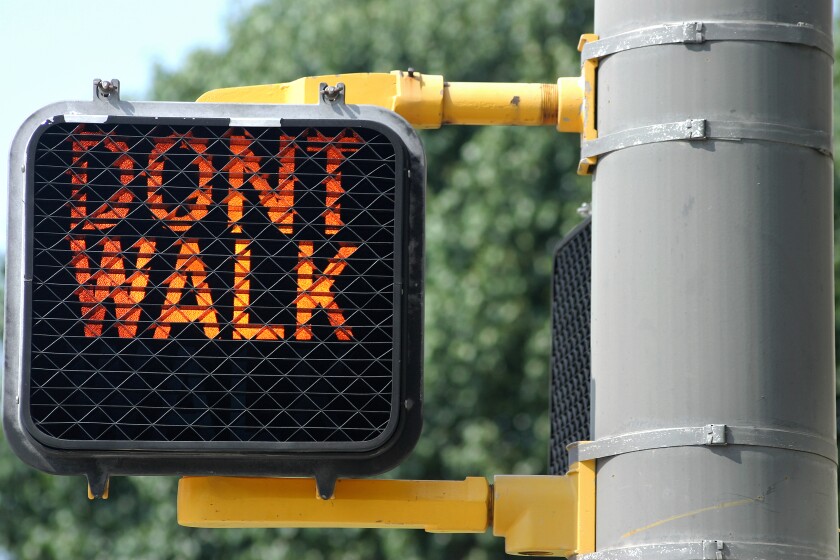In Brief:
In Seattle, they’re building new sidewalks, speed cushions, protected bike lanes and ADA accessible curb cutouts. In Philadelphia, they’re constructing pedestrian refuge islands and traffic signal modifications. In Louisville, they’re reconfiguring — or “rightsizing” — 10 streets to reduce speeds and improve traffic safety.
All of this work is being funded in part by the U.S. Department of Transportation’s (USDOT) Safe Streets and Roads for All (SS4A) program, a $5 billion component of the 2021 Infrastructure Investment and Jobs Act (IIJA).
And more grants are available to cities now.
Traffic injuries and deaths are on the rise around the U.S., and more pedestrians were killed on the roads last year than any other year in the last four decades. The trend is a challenge to big cities, many of which have adopted Vision Zero policies aimed at eliminating traffic deaths.
The first round of Safe Streets for All grants were awarded earlier this year, totaling $800 million in overall funding. USDOT is accepting applications for the next round until mid-July. The program is a unique opportunity for direct funding to cities, which often have to work through state departments of transportation to fund urban street projects.
“So much of the funding from the federal government in the past has gone through state DOTs, and what Safe Streets for All does is place funding directly into the hands of local transportation agencies,” says Jenny O’Connell, a senior program manager at the National Association of City Transportation Officials. “Local streets are the sites of many traffic fatalities and serious injuries, and local officials are very knowledgeable about what sorts of solutions to design on those streets.”
As the federal government works to roll out billions in funding from the IIJA and the Inflation Reduction Act, cities and states have new chances to pay for projects that make streets safer, neighborhoods more walkable and critical infrastructure more resilient to climate change. Here are details on a few.
Safe Streets and Roads for All
Research is evolving around what kinds of street designs are safest for city dwellers, but data recently published by the New York City Department of Transportation suggest that providing more street space to pedestrians can substantially lower the risks of injury and death. Many cities have laid the groundwork for projects by studying their high-injury networks and creating plans for intervention on specific streets and intersections. The Safe Streets and Roads for All program awards grants for plans and implementation. The first round of awards included 474 grants for planning work and 37 grants for implementation. Grants require a funding match of at least 20 percent.

(Shutterstock)
“Giving city agencies more control over the funding and timeline [of projects] is a really effective way to be able to address the traffic safety issues that cities are experiencing,” O’Connell says.
Surface Transportation Resilience
The Federal Highway Administration (FHWA) is also administering a program called Promoting Resilient Operations for Transformative, Efficient and Cost-Saving Transportation, or PROTECT, which is aimed at making transportation infrastructure more resilient to climate change and extreme weather. The program is open to applications from states, cities, metropolitan planning organizations and tribal governments. Grants are available to fund vulnerability assessments and other planning studies, and to pay for projects that protect highway infrastructure in coastal areas vulnerable to flooding and sea-level rise, and that create or strengthen evacuation routes for emergencies.
The FHWA is hosting a series of webinars in May. Applications are due Aug. 18.
Wildlife Crossings
America’s roadways are hazardous for people, but they can be even more hazardous for animals. FHWA is offering grants to cities, states, MPOs and tribes that want to build projects that connect wildlife habitats and reduce the risk of wildlife-vehicle collisions. The $350 million pilot grant program was established under the Infrastructure Investment and Jobs Act. All projects should “seek to protect motorists and wildlife,” according to the FHWA program description. The application period opened in April and closes Aug. 1.
Railroad Crossings and Neighborhood Walkability
More grant programs focused on mobility and street safety will open throughout the year, including annual Reconnecting Communities grants, which help cities address harms from historic infrastructure projects, and RAISE grants, which provide funding for transportation projects “with significant local or regional impact.” This summer, the Local Infrastructure Hub, an organization that provides technical assistance to communities looking for funding opportunities in the infrastructure bill, will also host a series of boot camps on various programs. They include programs that help cities eliminate railroad crossings to improve transportation safety and an upcoming program, called Neighborhood Access and Equity Grants, which was established through the Inflation Reduction Act.
Learn more about the trainings and register here. Applications are due May 31.
Related Articles














